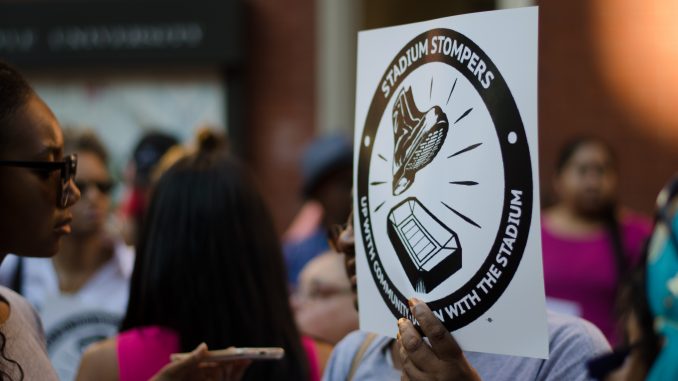
More than 100 members of the Anti-Stadium Coalition marched with banners, signs and bullhorns from Main Campus to City Hall on Tuesday to protest the university’s proposal for an on-campus stadium.
The coalition includes the Stadium Stompers, POWER, Black Clergy of Philadelphia and Vicinity, Temple Association of University Professionals, Socialist Alternative, Temple University Graduate Student Association, the Philadelphia NAACP and the National Action Network.
The march began outside of Sullivan Hall — where the majority of the university’s Board of Trustees meetings take place. The Board was scheduled to meet while the march was taking place, but the meeting’s location was changed to Ambler Campus for trustees to tour the campus, a university spokesperson said.
From the corner of Montgomery and Broad streets. pic.twitter.com/BLvGqNN2XK
— Will Bleier (@will_bleier) May 1, 2018
The university’s proposal for an on-campus stadium has been met with stark criticism and backlash, which has heated up this year when the university announced in January it would be seeking city approvals for the project. Temple officials said they hope to have approvals from the Philadelphia City Planning Commission by June.
At Ambler Campus, President Richard Englert spoke about the debate surrounding the stadium in his president’s report.
At Main Campus, members of the community organizations spoke to a crowd of residents, students and faculty about the project on Wednesday.
“Even though [the Board of Trustees] claim to have the best for the students and the community in mind, that couldn’t be further from the truth,” said Philip Gregory, a senior English major said to the crowd.
Protesters were accompanied by about fifty Philadelphia police officers on bicycles and in cars, who blocked off intersections as the group moved south on Broad street. A police spokesperson could not confirm how many officers policed the protest.
Upon reaching City Hall, the group gathered around the statue of civil rights activist Octavius Catto.
Marchers are convening on City Hall’s plaza near the statue of civil rights activist Octavius Catto. pic.twitter.com/v983yDRm1x
— Will Bleier (@will_bleier) May 1, 2018
Protesters bound for City Hall followed behind a hearse carrying a coffin. It wasn’t until arriving at the statue that the Rev Dr. William B. Moore of Tenth Memorial Baptist Church revealed why it was present.
Moore said it was symbolic of the university’s decision to build a portion of the stadium underground in an attempt to reduce noise. He then lead the crowd in a mock funeral for the stadium proposal.
“They can keep on digging, and bury it,” he said.
The crowd remained peaceful throughout the march, mostly chanting “No stadium, no deal,” “No justice, no peace” and “Temple, Temple you can’t hide. We can see your dirty side.”
Community residents and advocacy group leaders gave speeches at the City Hall plaza.
“Our tax dollars are meant for us,” Gail Loney, a 56-year-old block captain, said to the crowd. “The public officials need to understand that public means us. We have a voice and we need to use it.”
“We are putting public officials on notice,” Paula Pebbles, the Pennsylvania state chair of the National Action Network, said to the crowd. “If you vote for Temple’s stadium we are going to vote you out of the council next year.”
Philadelphia City Council President has opposed the university’s current stadium proposal, stating the university must win over the community before he approves of the project.
Read about City Council President Darrell Clarke’s stance on the proposed stadium
Jason Del Gandio, a professor in the department of communication and social influence, said marches like these could be a venue to bring publicity to the anti-stadium coalition’s message.
“Even if you don’t win your campaign or achieve your ultimate goal, public displays of collective resistance help tell the underside of the story,” said Del Gandio, who taught classes on urban organizing and civil disobedience in Spring 2018. “If the stadium passes and if it’s built it’s important to recognize that it wasn’t built without resistance, it doesn’t represent all the wants and all the needs in the community.”
“This campaign can also help galvanize other campaigns,” he added. “So even if it fails this time you can still bring together people to fight for other causes in the future.”



Be the first to comment